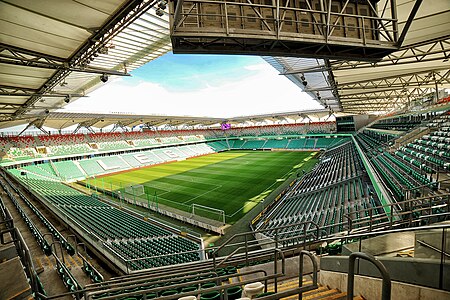Stadion Wojska Polskiego

The Stadion Wojska Polskiego (pronounced [ˌstadjɔn ˌvɔjska pɔlˈskʲɛɡɔ], English: Polish Army Stadium), officially named Stadion Miejski Legii Warszawa im. Marszałka Józefa Piłsudskiego (English: The Marshall Józef Piłsudski's Municipal Stadium of Legia Warsaw) in Warsaw, Poland, is an all-seater, highest fourth category football-specific stadium. The venue is located at the 3 Łazienkowska Street in Śródmieście district. It is the home ground of Legia Warsaw football club, who have been playing there since 9 August 1930. The stadium underwent a two-stage, complete reconstruction in the years 2008–2011. Only a small part of the main building facade was preserved from the old construction (with another part being precisely reconstructed). With space for 31,800 spectators it is the 5th biggest football stadium in Ekstraklasa and the 7th biggest in the country. The stadium is equipped with a heated pitch, training pitch, underground parking, sport bar, club museum and other facilities. The stadium, which for decades belonged to the Polish Armed Forces, is currently owned by the City of Warsaw.
Excerpt from the Wikipedia article Stadion Wojska Polskiego (License: CC BY-SA 3.0, Authors, Images).Stadion Wojska Polskiego
Łazienkowska, Warsaw Śródmieście (Warsaw)
Geographical coordinates (GPS) Address External links Nearby Places Show on map
Geographical coordinates (GPS)
| Latitude | Longitude |
|---|---|
| N 52.220461111111 ° | E 21.040627777778 ° |
Address
Stadion Miejski Legii Warszawa im. Marszałka Józefa Piłsudskiego (Stadion Legii)
Łazienkowska 3
00-449 Warsaw, Śródmieście (Warsaw)
Masovian Voivodeship, Poland
Open on Google Maps









